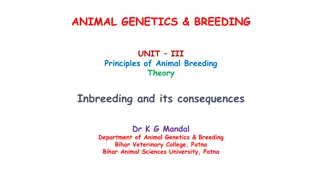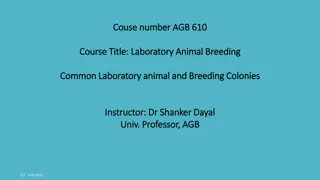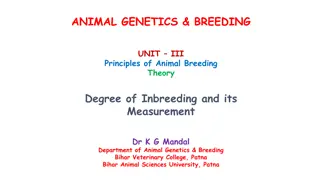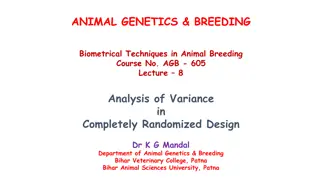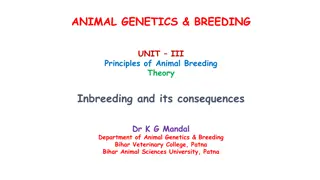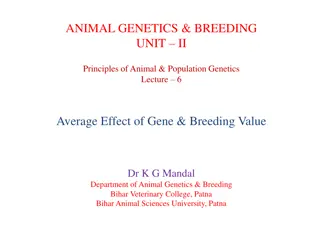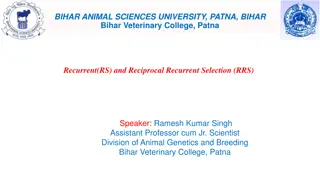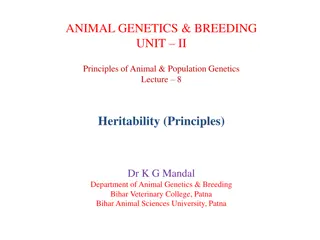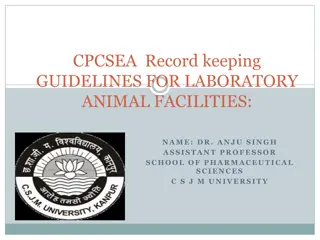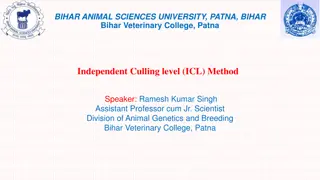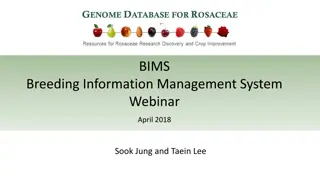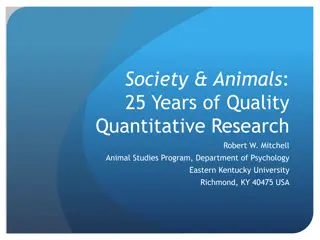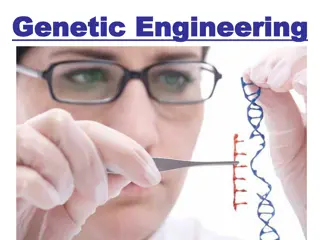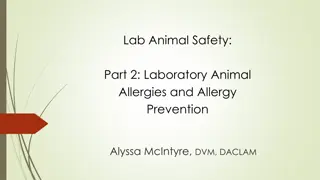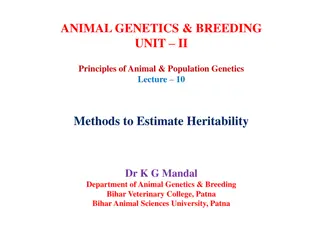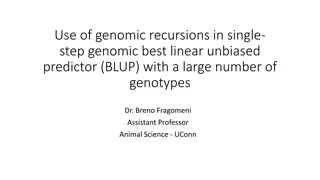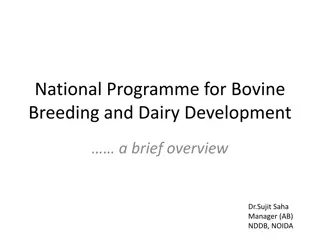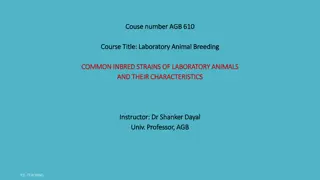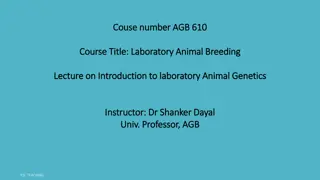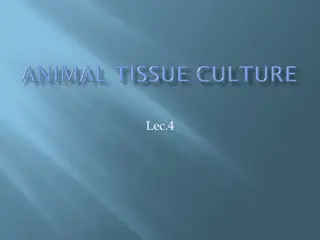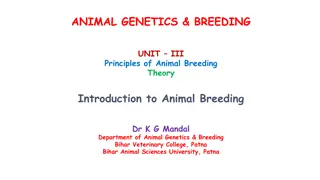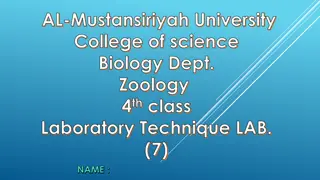History and Educational Programs of DEU Lab Animal Science Department
Established in 2004, the Department of Laboratory Animal Science at Dokuz Eylul University Institute of Health Sciences offers cutting-edge education focusing on animal welfare and ethical practices in scientific research. The department upholds the 3R Principle—Reduction, Refinement, Replacement�
0 views • 9 slides
Guide to Efficient Rodent Breeding and Colony Management
This comprehensive guide covers essential aspects of rodent breeding, colony management, and tips for successful rodent reproduction. It includes details on weaning, retiring breeders, records management, problem-solving, resources, goals and planning, breeding systems, reproduction processes, genot
5 views • 35 slides
Inbreeding and Its Consequences in Animal Genetics & Breeding
Inbreeding in animal breeding involves mating closely related individuals, resulting in common ancestors within the preceding generations. This practice can have both positive and negative consequences on genetic diversity and health. Various types of inbreeding such as selfing, full-sib mating, and
1 views • 18 slides
Principles of Animal Breeding: Introduction and Historical Perspective
This unit covers the introduction to animal breeding, the application of genetics principles in breeding, historical perspectives including the work of Robert Bakewell, and key events in animal breeding evolution. Topics include breeding systems, importance of animal breeding, and notable figures in
1 views • 12 slides
Laboratory Animal Breeding and Mutant Mouse Strains in Research
Laboratory Animal Breeding course AGB 610 covers the use of mice in research, highlighting their value, ease of handling, and diverse genetic mutants available. The course explores the popular mouse strains used by immunologists and oncologists, including athymic nude mice and mutants like dh and lp
0 views • 16 slides
Importance of Training in Animal Care and Use for Research
Training in animal care and use is essential to ensure humane and appropriate treatment of research animals, promote regulatory compliance, and uphold high standards of science and animal well-being. The presentation covers the necessity of training, goals including reviewing animal use and identify
0 views • 53 slides
Degree of Inbreeding in Animal Genetics and Breeding
Degree of inbreeding refers to the extent to which an individual carries genes identical by descent. This concept is crucial in animal breeding as it affects genetic diversity and homozygosity in offspring. The coefficient of inbreeding is used to measure the level of inbreeding, with higher values
1 views • 30 slides
Fish Breeding and Spawn Management Techniques by Dr. S.P. Sahu
Dr. S.P. Sahu, an Assistant Professor at Bihar Veterinary College in Patna, provides valuable insights into fish breeding and spawn management. The content covers fish seed collection, procurement methods, fry identification, and confined water breeding techniques. Detailed information on Indian maj
3 views • 26 slides
The Difference: Animal Rights vs. Animal Welfare
Explore the nuanced distinction between animal rights and animal welfare, delving into the ethical considerations, philosophies, and advocacy efforts surrounding these concepts. Discover how animal rights proponents emphasize the equal rights of animals, while animal welfare focuses on humane treatm
0 views • 36 slides
Biometrical Techniques in Animal Breeding: Analysis of Variance in Completely Randomized Design
Biometrical techniques in animal breeding involve the use of analysis of variance (ANOVA) to partition total variance into different components attributable to various factors. In completely randomized designs, experimental units are randomly assigned to treatments, ensuring homogeneity. The total n
1 views • 34 slides
Inbreeding in Animal Genetics & Breeding
Explore the principles of animal breeding theory focusing on inbreeding and its consequences, including examples like selfing, full-sib mating, and genetic effects. Learn about close breeding, line breeding, and genetic consequences of inbreeding in animal populations. Discover how inbreeding affect
1 views • 13 slides
Livestock Breeding Policy for Genetic Improvement of Cattle and Buffalo in India
India's diverse agro-ecological regions host a wide range of farm animal breeds. The livestock breeding policy aims to enhance the productivity of cattle and buffalo through strategies such as grading up with indigenous superior dairy breeds, crossbreeding with high-yielding exotic breeds, and selec
2 views • 23 slides
Principles of Animal Breeding: Selection and its Basis
Selection in animal breeding involves choosing the best individuals to improve specific traits. Criteria for selection include individual merit, competitive exams, and interviews. Selection of farm animals focuses on non-random reproduction of genotypes. Types of selection include natural and artifi
1 views • 40 slides
Principles and Systems of Poultry Breeding: A Comprehensive Guide
Poultry breeding, led by experts like Dr. Suchit Kumar, involves purposeful selection and mating to improve size, weight, egg production, and meat quality. Environmental factors are crucial, and different breeding systems like inbreeding and line breeding play a role in genetic improvement. Continuo
2 views • 21 slides
Principles of Animal Genetics and Breeding in Farm Animals
Explore the fundamentals of animal genetics and breeding with a focus on inheritance, variation, and genetic improvement in farm animals. Learn how genetics principles, population genetics, and molecular genetics play a vital role in enhancing livestock production. Discover the economic traits in ca
1 views • 16 slides
Average Gene Effect and Breeding Value in Animal Genetics
In the field of animal genetics and breeding, it is crucial to comprehend the average effect of genes and breeding value of individuals. Genes are transmitted from parents to offspring through haploid gametes, influencing the genotype and breeding potential. Estimating the average effect of a gene i
6 views • 26 slides
Principles of Animal Breeding Theory and Methods of Selection
Animal breeding involves selecting for desirable traits to improve the overall merit of animals. Methods such as tandem selection and multi-trait selection are used to enhance genetic progress. Economic value, genetic significance, and selection criteria play important roles in the breeding process.
2 views • 16 slides
Design of Experiment in Animal Genetics & Breeding: Principles and Methods
Biostatistics and computer applications play a key role in the design of experiments in animal genetics and breeding. Proper allotment of treatments to experimental units is crucial to study treatment effects accurately. Designing experiments helps in maximizing information from available resources,
0 views • 37 slides
Selection Strategies in Animal Genetics and Breeding
Genes influence traits through Additive Gene Action (AGA) and Non-Additive Gene Action (NAGA) in animal breeding. Recurrent Selection (RS) and Reciprocal Recurrent Selection (RRS) play crucial roles in improving animals. Selection for General Combining Ability (GCA) and Specific Combining Ability (S
0 views • 16 slides
Heritability in Animal Genetics and Breeding
Heritability is a crucial concept in animal genetics and breeding, indicating the proportion of total phenotypic variance attributed to genetic effects. It helps in predicting breeding values, assessing relationships between individuals, and guiding genetic determinations. Properties of heritability
3 views • 20 slides
Laboratory Animal Facilities Record-keeping Guidelines
Guidelines for maintaining records in laboratory animal facilities include provisions for animal housing, staff records, health monitoring, and standard operating procedures. Compliance with CPCSEA regulations ensures ethical review procedures for animal research proposals. Focus is on providing a s
6 views • 11 slides
Guidelines for Recording Keeping in Laboratory Animal Facilities
The Committee for the Purpose of Control and Supervision of Experiments on Animals outlines the importance of maintaining detailed records in laboratory animal facilities to ensure the well-being and proper management of animals used in experiments. Records ranging from animal house plans, staff hea
4 views • 5 slides
Fish Breeding Mating Strategies and Designs for Effective Population Management
Designing mating strategies to maximize the effective breeding population in fish hatcheries is crucial for maintaining genetic diversity and overall fitness. Random mating, simple paired mating, factorial mating, and other breeding designs are discussed to help hatchery managers improve breeding co
5 views • 13 slides
Achieving Comparable Results in Laboratory Practice
Good laboratory practice necessitates minimal error in measurement to reflect a patient's biological condition accurately, ensuring comparable and reliable results regardless of testing location or method. Standardization, harmonization, and traceability play crucial roles in achieving uniformity an
1 views • 29 slides
Independent Culling Level (ICL) Method in Animal Breeding
The Independent Culling Level (ICL) method involves selecting multiple traits simultaneously in animal breeding. Breeders set minimum or maximum culling levels for each trait, ensuring continuous improvement in desired characteristics through successive generations. However, challenges exist in dete
0 views • 6 slides
Shuttleworth College Animal Management Course Overview
Shuttleworth College offers an Animal Management course focusing on various aspects such as Animal Breeding, Welfare, Biology, Husbandry, Behavior, and more. The program includes practical and theoretical components with assessments and work experience opportunities. Students are guided by dedicated
0 views • 15 slides
Efficient Breeding Management System for Individual Breeders
Explore how the Breeding Information Management System (BIMS) empowers breeders to store, manage, and analyze breeding program data efficiently. With features like data integration, statistical analysis, and mobile app utilization, BIMS revolutionizes the way breeders make informed breeding decision
1 views • 45 slides
Human-Animal Interactions through 25 Years of Quality Research
Delve into the interdisciplinary realm of human-animal interactions with a focus on social sciences and quantitative research. Discover key themes such as social psychology, therapy, animal welfare, and more. Explore attitudes and personality differences related to animal treatment, empathy, and bel
1 views • 26 slides
Laboratory Related CRFs for Pharmacokinetics Study
This collection encompasses various CRFs related to laboratory procedures in the context of Pharmacokinetics for a study. It includes forms for enrollment, specimen storage, safety laboratory results, and specific days for sample collection. The CRFs detail the storage, collection, and documentation
1 views • 14 slides
Genetic Engineering and Selective Breeding
Genetic engineering involves changing the DNA in living organisms to create new traits, resulting in genetically modified organisms (GMOs). Techniques include artificial selection, cloning, gene splicing, and gel electrophoresis. Selective breeding is a form of artificial selection where animals wit
5 views • 37 slides
Laboratory Animal Allergies and Prevention
Laboratory animal allergies pose a significant occupational hazard, with around 2 million workers at risk. Exposure routes include inhalation, skin contact, and ingestion. Factors such as pre-existing allergies, intensity of exposure, and secondhand exposure influence the likelihood of developing al
0 views • 30 slides
Methods to Estimate Heritability in Animal Genetics and Breeding
Explore various methods to estimate heritability in animal genetics and breeding, including regression and correlation methods. Learn how to calculate heritability using offspring-parent data and understand the importance of choosing the most effective method for accurate estimations.
0 views • 19 slides
Selective Breeding: Benefits and Process
Selective breeding is a method where humans control the breeding of organisms to emphasize or eliminate specific traits. By choosing parents with desirable characteristics, breeders aim to create offspring with those traits. While advantageous for creating economically important varieties, it can al
0 views • 12 slides
Genomic Recursions in Genomic BLUP for Animal Breeding
Explore the application of genomic recursions in single-step genomic best linear unbiased predictor (BLUP) for genetic evaluations in animal breeding. Understand the significance of using genomic data to improve genetic selection, increase accuracy, shorten generation intervals, and enhance genetic
0 views • 31 slides
National Programme for Bovine Breeding and Dairy Development Overview
The National Programme for Bovine Breeding and Dairy Development (NPBBDD) is a Government of India funded project aimed at enhancing bovine breeding and dairy development in the country. It consists of two components: National Plan for Bovine Breeding (NPBB) and National Plan for Dairy Development (
0 views • 30 slides
Laboratory Animal Breeding: Common Inbred Strains and Characteristics
This course, AGB 610, on Laboratory Animal Breeding covers common inbred strains of laboratory animals and their unique characteristics. Detailed information is provided on popular strains like C57BL/6, C3H, BALB/c, DBA/2, CBA, and more, highlighting their susceptibility to diseases, tumor incidence
0 views • 7 slides
Laboratory Animal Genetics and Research Importance
This course (AGB 610) delves into the realm of laboratory animal breeding, exploring the significance of using animals in research and teaching. Dr Shanker Dayal, a distinguished professor, guides students through lectures on animal genetics and the common uses of laboratory animals. The course emph
1 views • 14 slides
Animal Tissue Culture and Cell Line Production
Animal tissue culture involves growing tissues separate from the animal in a laboratory setting. To achieve exponential cell growth, cells are converted into immortal cell lines. The production of a cell line involves steps like breaking cell adhesion, incubation, and transferring cells to fresh med
0 views • 22 slides
Principles of Animal Breeding: An Introduction to Genetics and Breeding Methods
This content provides an overview of animal breeding, discussing its historical perspective, breeding systems/methodologies, and the application of genetics for genetic improvement in plants and animals. It covers key figures like Robert Bakewell and their contributions to the field, as well as the
0 views • 12 slides
Laboratory Animal Testing in Science
Laboratory animal testing, also known as animal experimentation, involves using non-human animals in experiments to control variables affecting biological systems. Different species like mice, rats, rabbits, cats, dogs, and primates are utilized for research in various fields such as pharmacology, v
0 views • 10 slides


